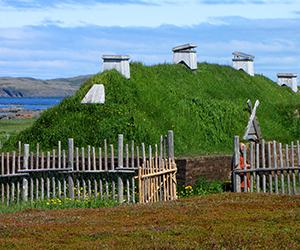CANADA HISTORY - War-New France
Fighting Ashore

The English campaign against Quebec in 1690 had all the hallmarks of a poorly coordinated military effort, its shortcomings becoming increasingly evident as the days dragged on. After an initial period of inactivity on the 16th of October, the English found themselves further delayed by poor weather on the 17th, which thwarted any attempt to land their forces. It wasn’t until the 18th that Major John Walley, commanding the landing force, was finally able to disembark his troops—some 1,200 to 1,300 men—on the marshy shores of La Canardière, east of the city. This initial phase of the operation proceeded without resistance, but that would soon change.
On the French side, Count Louis de Buade de Frontenac, Governor of New France, was prepared for the English assault and had a well-considered plan in place. In his dispatches to the Minister of Marine, he outlined his strategy. Though he had three battalions of French regulars at his disposal, Frontenac wisely decided not to deploy them in the rugged, broken terrain beyond the St. Charles River. This area, characterized by dense woods, rocks, and muddy foreshore, was unsuitable for European-style military tactics. Instead, Frontenac relied on his experienced Canadian officers, local militia, and Indigenous allies, all of whom were adept at guerrilla warfare in such an environment. Among the Canadian officers were two of the famed Le Moyne brothers, including Jacques Le Moyne de Sainte-Hélène, who would emerge as one of the heroes of the defense. Frontenac entrusted these irregular forces with the task of harassing the English as they attempted to advance inland. Meanwhile, his regular battalions remained positioned on the Quebec side of the river, prepared for a decisive engagement on more favorable ground.
Frontenac’s plan was to lure the New England forces into crossing the St. Charles at low tide, where they would be exposed and vulnerable. Once the English were across, Frontenac intended to strike hard with his regulars, pinning the invaders against the river and driving them into the water as the tide rose, effectively annihilating them. It was a sound strategy, making the best use of both terrain and the available forces. But the English, hampered by poor logistics and communication, would never progress far enough to trigger the French governor's full counterattack.
As soon as Walley’s men began their inland movement, they encountered stiff resistance. Frontenac, true to his plan, had dispatched a force of Montreal and Trois-Rivières militia under Sainte-Hélène to join local militia and Indigenous warriors in harrying the English. These irregulars, skilled in skirmishing from cover, inflicted steady casualties on the advancing New Englanders. Walley later reported that his forces suffered four killed and no fewer than 60 wounded during this phase of the operation. As darkness fell, the English were forced to halt their advance and make camp for the night, expecting that the ships’ boats would arrive with the tide to help ferry their men and artillery across the river.
But this hope was soon dashed. The boats never came, with the shipmasters blaming the wind for their failure to reach the landing site. To compound the problem, six field guns, which were supposed to be landed west of the St. Charles in support of the ground assault, were instead offloaded near Walley’s camp without warning. Walley had no means of moving them across the river, further crippling his ability to mount an effective attack. The English plan was beginning to unravel, its complexity proving too much for the militia forces and their uncoordinated command structure.
Meanwhile, Sir William Phips, the overall commander of the English expedition, made a critical miscalculation. Rather than waiting for Walley’s forces to cross the St. Charles and join in the assault on Quebec, Phips ordered his four largest ships to sail upriver and begin bombarding the town on the evening of October 18th. Anchored within musket range of the shore, Phips’ ships opened fire on Quebec, but the response from the French batteries was swift and punishing. The bombardment continued into the night and resumed the following morning, but Quebec’s fortifications held firm. The stone buildings of the Lower Town, well-constructed and designed to withstand such attacks, suffered little damage, while Phips’ ships—particularly his flagship, the Six Friends—were badly battered. After several hours of fruitless cannon fire, the English fleet was forced to withdraw, having expended much of its ammunition without inflicting significant damage or casualties on the French defenders.
While Phips engaged in his ill-advised naval bombardment, Walley’s landing force remained stagnant, doing nothing to exploit the diversion created by the fleet’s actions. The New England troops, already suffering from cold as winter approached early, were further demoralized by a lack of provisions—most notably rum—and the outbreak of smallpox in the camp. Without support from the fleet’s boats, they were effectively stranded on the far side of the St. Charles, unable to mount an assault or even withdraw in good order. On the night of October 19th, a council of war convened by Walley recommended re-embarking the troops and attempting another assault at a different location after the men had been refreshed. The following morning, Walley presented this plan to Phips, who reluctantly agreed.
Before the English could evacuate, however, another skirmish broke out. According to Monseignat, a French chronicler of the battle, the English vanguard appeared to be preparing to cross the St. Charles in the afternoon of the 20th. Seeing this, Frontenac ordered his regular battalions to march out to the chosen battlefield, forming them in battle order on the Quebec side of the river, with Frontenac himself at their head. He anticipated that the moment for his decisive counterattack had arrived, but the English never crossed. The elusive Sainte-Hélène, who had returned to the Beauport shore, continued to lead his Canadian skirmishers in harassing the English column, preventing them from advancing further. In the ensuing clash, Sainte-Hélène was mortally wounded by a musket ball, and his brother Le Moyne de Longueuil was also injured. The French lost several men, but the English advance had been halted once again.
That night, as Walley prepared his men for evacuation, the fleet’s boats finally arrived, but there was too little time and too much confusion to effect the retreat. It wasn’t until the night of October 21st that the English landing force was successfully withdrawn, leaving behind five of the six cannons they had brought ashore. By then, the French had little opportunity to interfere with the retreat, and Walley’s men re-embarked under the cover of darkness. The New England fleet, demoralized and depleted, sailed away from Quebec on October 24th, having failed to breach the city’s defenses.
The English retreat came not a moment too soon for New France, which was facing a food shortage with most of its able-bodied men gathered at Quebec. Had the siege continued, the defenders may have faced starvation before reinforcements or provisions could arrive. Nevertheless, the failure of the 1690 expedition was a crushing blow to Massachusetts. The campaign had drained the colony’s coffers, forcing it to issue paper currency for the first time in its history to cover the expenses. While Boston mourned its defeat, Quebec celebrated. The failure of Phips’ expedition solidified Frontenac’s reputation as the steadfast defender of New France, while the English returned home, having gained nothing from their costly venture.
In the end, Frontenac’s decision to rely on guerrilla tactics and local forces in the broken terrain, rather than committing his European regulars to an ill-suited offensive, proved wise. He had weathered the storm and preserved Quebec for another day, laying the groundwork for future generations of French defenders to resist their English adversaries in the long struggle for North America.
Cite Article : Reference: www.canadahistory.com/sections/documents/documents.html
Source: NA



